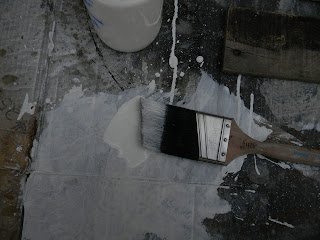Supplies needed:
- set of encyclopedia's
- paint (white and dark grey)
- stain (dark walnut)
- galvanized plumbing flange, rod, and coupling (size is up to you)
- sandpaper 150grit
- drywall screws 1 5/8" (course)
- edison bulb
- lamp wire about 10' / plug / light socket
- drill
- boring bit (1/2")
step 1: acquiring your encyclopedia set
some of you have one in storage waiting to be used for a project like this or perhaps you may have to hit a few yard sales like i did. what ever way for a couple of bucks there's a set out there for you (mine cost $3 bucks).
 | |
| my yard sale score and jump off for the project $3 bucks |
step 2: stacking your set and attaching them together
starting from the last volume in the set screw each one together. set on a solid surface with the last volume first and in sequence screw together one at a time about 4 screws each (be sure to random the pattern so they wont hit each other, diamond/square works well and make sure the screws are long enough to get a good bite 1 5/8" worked for me). the stack should look like the pic in step one when done.
step 3a: distressing and getting that aged vintage look
the first stage to this process is painting your stack out white. be sure to get all the nooks and cranny's then let dry.
 |
| step 3a painting out white |
step 3b: dry brush the stack with dark gray
going one direction and using light long strokes dry brush with gray.
Q: what is dry brushing?
good question and I'm glad you asked. dry brushing is very simple once you dip your brush into paint tamp off all excess paint so the brush isn't loaded with paint.
you don't need to cover the entire area random dark gray throughout the stack goes a long way. let dry
 |
| step 3b dry brushing with dark gray |
step 3c: dry brushing with dark brown stain
in this step you use the same technique as in step 3b only using your dark stain stain. let dry
 |
| step 3c dry brushing with dark stain |
step 4: aging and distressing
with 150 grit sandpaper start distressing your books. you want to get area's that look blotchy first (they sand out pretty easy). the goal is to make them look natural. select other random area's and area's that would be naturally worn down over time (like corners). for corners a file works well if you have one.
NOTE: i used the existing numbers on my set to make them look more authentic. You'll just need to sand a bit more in those areas to bring them out. try not to over dot it...
 |
| step 4 distressing and aging |
 |
| step 4 corners distressed and aged |
step 5: drilling the necessary hole through the stack for wiring
this step is by far the hardest but really if you have a long boring bit it's pretty easy. find what you think to be center of your stack and start drilling.
 |
| step 5 and what a 1/2" boring bit looks like |
 |
| step 5 bottom and center of stack |
step 6: attaching flange and running wire
on the top of your stack attach your pipe flange (i've chosen 3/4" pipe and hardware) attach flange with 3" deck screws over drilled out hole.
feed wire from bottom up pull enough and attach pipe to flange.
 |
| step 6 bottom of stack feeding wire |
 |
| step 6 attaching flange over bored out center hole |
 |
| step 6 attaching pipe to flange |
step 7: hooking up electrical
it's pretty simple to hook up the electrical to plug and socket positive to positive and negative to negative. assemble the rest of socket and test.
 |
| step 7 wire fed up through bottom of stack |
 |
| step 7 attaching the 2 leads to socket |
 |
| step 7 socket assembled |
step 8: elevating stack to accommodate cord at the bottom
now that the cord is running directly through the center of stack we need to elevate it so the stack sits upright and stable. for this i used 4 3/8" x 3" lag screws one at each corner of stack. once lags are attached place a rubber sticky bumper on each to prevent your project from scratching what ever it may sit on.
 |
| step 8 close up of lag and rubber bumper |
 | |
| step 8 view of the elevated stack accommodating the cord |
for about $30 bucks worth of material or less depending on what you have laying around the house we have a unique industrial chic with vintage appeal steam-punk lamp. on to the next one...











































